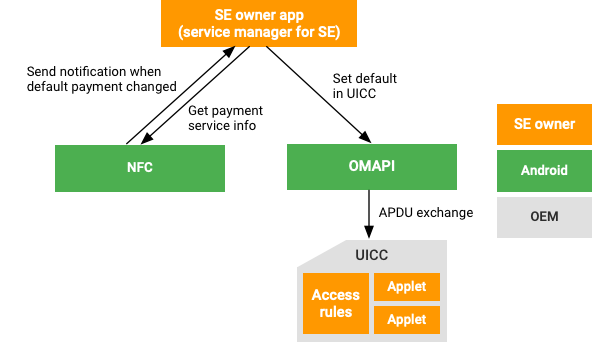Android mendukung emulasi kartu NFC dengan elemen pengaman untuk emulasi kartu di luar host. (Untuk mengetahui informasi selengkapnya, lihat Ringkasan emulasi kartu berbasis host.) Namun, di platform Android, layanan pembayaran pilihan yang ditentukan dalam setelan Tempel & bayar tidak selalu disinkronkan dengan aplikasi di elemen aman. Artinya, layanan pembayaran yang tidak disukai di elemen aman dapat digunakan, bukan layanan pembayaran yang disukai.
Di Android 11, fitur sinkronisasi pembayaran di luar host menyediakan mekanisme yang memungkinkan Anda menyinkronkan konfigurasi pembayaran di Tempel & bayar, konfigurasi perutean di frontend nirsentuh (CLF), dan status yang dipilih aplikasi di elemen aman.
Diagram berikut mengilustrasikan arsitektur desain fitur sinkronisasi pembayaran di luar host.

Implementasi
Untuk menerapkan fitur sinkronisasi pembayaran di luar host, perangkat harus memiliki pengontrol NFC yang mendukung standar NCI 2.0 dan harus menggunakan framework NFC dan Open Mobile Application Programming Interface (OMAPI) Android Open Source Project.
Framework API
Untuk menerapkan sinkronisasi pembayaran di luar host, gunakan API framework berikut yang ada di Android Open Source Project:
getAidsForPreferredPaymentService(): Mengambil AID (ID Aplikasi) terdaftar untuk layanan pembayaran pilihan.getRouteDestinationForPreferredPaymentService(): Mengambil tujuan rute untuk layanan pembayaran pilihan.getDescriptionForPreferredPaymentService(): Menampilkan deskripsi layanan pembayaran pilihan yang dapat dilihat pengguna.android.permission.NFC_PREFERRED_PAYMENT_INFO(izin): Mengizinkan aplikasi menerima informasi layanan pembayaran pilihan NFC.android.nfc.action.PREFERRED_PAYMENT_CHANGED(tindakan siaran): Memberi tahu jika layanan pembayaran pilihan berubah.
Validasi
Untuk memvalidasi penerapan fitur sinkronisasi pembayaran di luar host, instal aplikasi elemen aman dengan elemen aman yang sesuai, lalu periksa respons yang sesuai dari pembaca NFC dalam berbagai kondisi.

